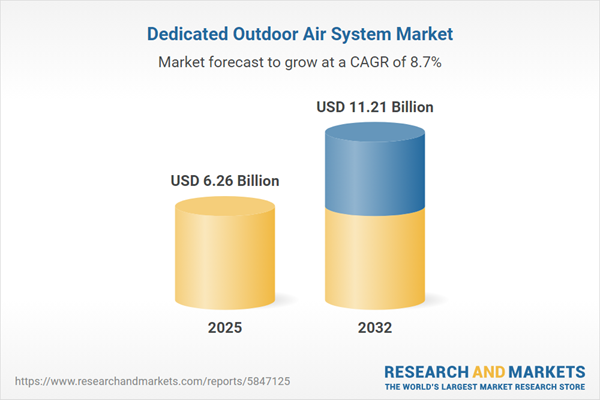Speak directly to the analyst to clarify any post sales queries you may have.
As organizations prioritize healthier, compliant, and adaptable facilities, dedicated outdoor air systems are becoming a strategic focus for real estate leaders looking to future-proof building portfolios. These solutions support operational agility and efficient environmental management.
Market Snapshot: Dedicated Outdoor Air System Market Growth & Outlook
The dedicated outdoor air system market is experiencing noticeable momentum, currently valued at USD 5.75 billion and anticipated to reach USD 6.26 billion by 2025. Looking ahead, market forecasts suggest expansion to USD 11.21 billion by 2032, reflecting a compound annual growth rate of 8.68%. Continued building modernization, tightening air quality standards, and evolving operational models are primary growth drivers. Senior decision-makers across sectors are closely evaluating innovative HVAC technologies and adjusting procurement strategies to maximize efficiency and compliance in a dynamic environment.
Scope & Segmentation of the Dedicated Outdoor Air System Market
This dedicated outdoor air system market analysis delivers senior executive teams a detailed landscape of solution categories, technology options, and geographic distinctions essential for building resilience and competitive advantage in real estate and facilities management. The segmentation defines investment paths, highlights sector-specific opportunities, and assists in adapting to regional requirements.
- Applications: Healthcare, education, data centers, hospitality, manufacturing, offices, and retail each gain from enhanced air quality, regulatory compliance, and adaptable space use, addressing operational complexities across diverse asset types.
- Technologies: Key system designs include desiccant wheels, enthalpy wheels, heat pipes, and run-around coils, all engineered to strengthen dehumidification, minimize energy consumption, and support climate-focused strategies.
- Product Types: Constant air volume, modular, dual duct variable air volume, and single duct variable air variants provide flexible upgrade or retrofit options suitable for both expanding campuses and existing properties.
- Airflow Capacities: Ranges from high, medium, to low airflow models facilitate tailored solutions for different operational scales, from enterprise facilities to specialized areas within larger buildings.
- Mount Types: Ceiling, floor, rooftop, and wall-mounted configurations ensure streamlined integration in both new construction and renovation projects, allowing alignment with various facility layouts.
- Control Types: Automated and manual control systems empower facility teams to customize air delivery and operational routines, supporting precise energy management and occupant comfort.
- Regions: North America, Latin America, Europe, the Middle East, Africa, and Asia-Pacific each show distinct adoption trends, shaped by local regulation, infrastructure maturity, and climate considerations.
- Major Participants: Providers such as Carrier Global Corporation, Daikin Industries, Trane Technologies, Johnson Controls International, LG Electronics, Mitsubishi Electric, Midea Group, Lennox International, Fujitsu General, and Hitachi are expanding solution portfolios to address global and local requirements.
Key Takeaways for Senior Decision-Makers
- Dedicated outdoor air systems provide operational stability and strengthen compliance with air quality mandates, aligning with long-term asset management strategies.
- Modular and scalable system designs enable rapid adaptation to shifts in building use or tenant demands while minimizing service interruptions and safeguarding ongoing operations.
- Specifying durable and adaptable systems reduces the risk of unplanned downtime and prepares operations for evolving compliance requirements across different jurisdictions and sectors.
- Advanced diagnostics and built-in analytics support predictive maintenance programs, extending the useful life of equipment and decreasing emergency interventions.
- Aligning system selection with local compliance frameworks and operational preferences ensures dependable performance and simplifies portfolio management on a global scale.
Tariff Impact: United States Tariff Changes in 2025
Recent U.S. tariff adjustments on components such as heat exchangers and control modules prompt organizations to refine procurement strategies. Property managers and manufacturing leads are reviewing supply arrangements, renegotiating agreements, and updating pricing structures to help manage cost fluctuations and safeguard against supply chain volatility arising from new policy changes.
Methodology & Data Sources
The dedicated outdoor air system market research relies on in-depth technical publications, peer-reviewed studies, and current regulatory documents. Strategic insights are further supported by direct interviews with market executives and engineering specialists.
Why the Dedicated Outdoor Air System Market Report Matters
- Empowers executive teams to align infrastructure investments with risk mitigation, operational priorities, and asset performance goals.
- Regional segmentation facilitates proactive responses to compliance issues and supports consistent deployment across multi-region portfolios.
- Market intelligence promotes supplier collaboration and flexibility in the face of evolving regulatory and supply chain landscapes.
Conclusion
Implementing dedicated outdoor air systems helps organizations maintain efficiency, meet compliance targets, and prepare for shifting operational requirements. These technologies support resilient, high-performing environments across complex real estate portfolios.
Additional Product Information:
- Purchase of this report includes 1 year online access with quarterly updates.
- This report can be updated on request. Please contact our Customer Experience team using the Ask a Question widget on our website.
Table of Contents
3. Executive Summary
4. Market Overview
7. Cumulative Impact of Artificial Intelligence 2025
Companies Mentioned
The companies profiled in this Dedicated Outdoor Air System market report include:- Carrier Global Corporation
- Daikin Industries, Ltd
- Trane Technologies Company
- Johnson Controls International PLC
- LG Electronics Inc.
- Mitsubishi Electric Corporation
- Midea Group Co., Ltd
- Lennox International Inc.
- Fujitsu General Limited
- Hitachi, Ltd
Table Information
| Report Attribute | Details |
|---|---|
| No. of Pages | 189 |
| Published | November 2025 |
| Forecast Period | 2025 - 2032 |
| Estimated Market Value ( USD | $ 6.26 Billion |
| Forecasted Market Value ( USD | $ 11.21 Billion |
| Compound Annual Growth Rate | 8.6% |
| Regions Covered | Global |
| No. of Companies Mentioned | 11 |









